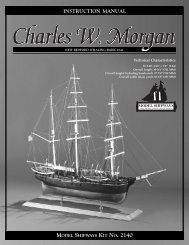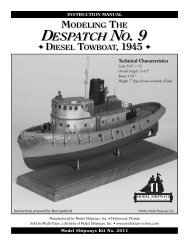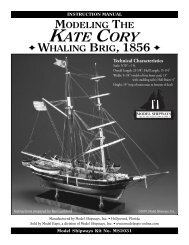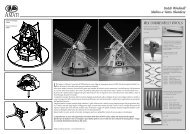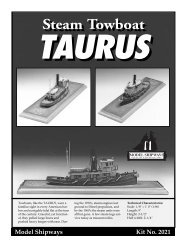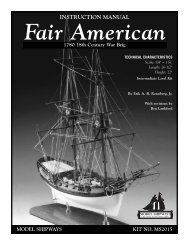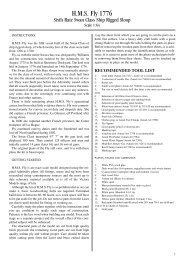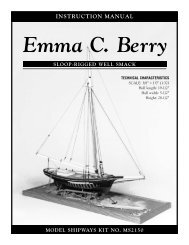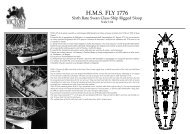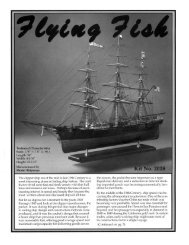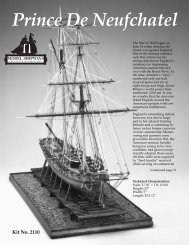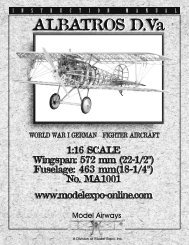download benjamin latham instruction manual
download benjamin latham instruction manual
download benjamin latham instruction manual
Create successful ePaper yourself
Turn your PDF publications into a flip-book with our unique Google optimized e-Paper software.
10. Ironwork<br />
Ironwork is somewhat more difficult to make for the gaffs and<br />
booms than for the masts and bowsprit. The bands are smaller,<br />
more complicated, and drilling a thin dowel for the eyebolts<br />
and sheave holes is a tricky job at times (see figure 51 for<br />
the different types of bands required for these spars).<br />
Booms: The fore boom gooseneck has been illustrated in figure<br />
46 and the jumbo boom gooseneck appears in figure 52. If<br />
you wish to fake the ironwork with paper and wire, simplified<br />
assembly methods are shown in figure 51.<br />
Gaffs: The ironwork for the gaffs is not as demanding. Throat<br />
halyard blocks and hardware have been shown in figure 44.<br />
This should be a thoroughly enjoyable project for the modeler<br />
who finds fine metalwork an interesting challenge, which it<br />
should be. The fore peak halyard blocks are fixed to bands on<br />
the gaff (see figure 53a). The main peak halyard blocks run on<br />
wire bridles which are seated in shallow grooves in the gaff<br />
(see figure 53b). These block bridles are discussed in the section<br />
on standing rigging.<br />
The ends of the gaffs are fitted with blocks for the topsail<br />
sheets. The fore has two cheek blocks (important note: the fore<br />
topsail sheets are double!). The main has a single block shackled<br />
to a band. The main gaff also must have a band with an<br />
eye-strap for the flag halyard (see figure 54).<br />
Bowsprit: There is much ironwork to be fitted for this spar<br />
which includes the bobstay irons and gammon irons (See figures<br />
55 and 57). First, fit the wooden jackstays onto both sides<br />
of the bowsprit along its upper outboard edges (see figure 56).<br />
Drill them out for the jib stops (for locations see Rigging Plan<br />
Sheet 2 and upper left corner of sheet 3. Near the end of the<br />
bowsprit is a withe (four eyes) to which the outer bobstay, the<br />
jibstay and the bowsprit guys are shackled (see figure 58). Just<br />
inside of this withe is fitted a brace band (no eyes) which supports<br />
the former by helping to distribute some of the compression<br />
loads. The brace band may be faked with paper, but the<br />
withe might be better made with metal. Or, you can use a brittania<br />
metal casting provided for the purpose.<br />
On the underside of the bowsprit, abaft the bands of the lifesize<br />
Latham was a long plate for the inner bobstay. Passing<br />
through that plate was a heavy metal staple which formed the<br />
bobstay eye. The ends of this staple were headed over clinch<br />
rings on the upper side of the bowsprit (see figure 58). On the<br />
model, the metal plate can be simulated with heavy paper, but<br />
the eye must be very secure. Form a small staple from a common<br />
pin. Next, drill a hole in the bowsprit for it. Then drive<br />
the pin up through the hole and bend the ends over neatly.<br />
Outboard of the bands projects the pole of the bowsprit, from<br />
which the balloon stay is shackled. This pole has a longitudinal<br />
band running its whole length, above and below, and is recessed<br />
into the wood. A strip of rag paper will represent that<br />
fitting nicely. An eyebolt can be driven through the pole and<br />
headed over underneath to accommodate the jibstay.<br />
Seine boat & net booms: The ironwork for these is quite simple<br />
and covered in detail on the seining gear Plan Sheet 4 of 4.<br />
FIG. 52 – Jumbo Boom FIG. 53a – Peak Halyard Straps & Bridles FIG. 53b – Bridle for Main Peak Halyard Blocks<br />
ACTUAL<br />
FOR<br />
MODEL<br />
ACTUAL<br />
(popular at turn of century)<br />
Iron roller or saddle<br />
Knot<br />
Goose neck<br />
FORWARD VIEW<br />
Iron strap<br />
(all fore gaffs and many or most main gaffs)<br />
Splice<br />
Make a fine<br />
groove in gaff<br />
for bridle<br />
FOR<br />
MODEL<br />
FIG. 54 – Gaff Ends<br />
Topsail sheet block<br />
Wood cheek block,<br />
port side<br />
Cheek blocks,<br />
port & starboard<br />
Iron band<br />
or<br />
Double<br />
topsail sheets<br />
Flag<br />
halyard<br />
block<br />
Peak outhaul<br />
Peak outhaul<br />
1. For larger vessels 2. Probally better for Latham<br />
MAIN GAFF<br />
FORE GAFF<br />
29



